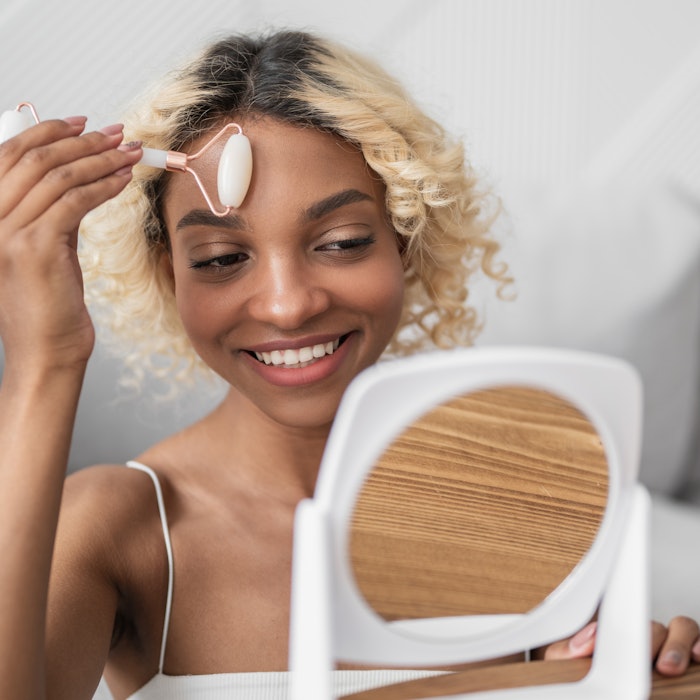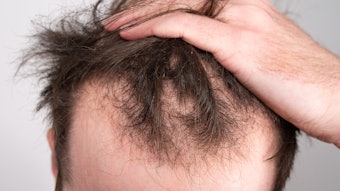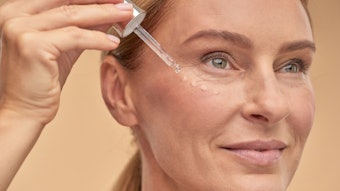
In this edition of Next in Skin, columnist Katerina Steventon, Ph.D., gives an insider’s view of a discussion held in October 2024 in Manchester, wherein experts in neuroscience and cosmetic science gathered to discuss facial touch and its implications for cosmetics. Following is a summary.
This multidisciplinary meeting explored the transformative role of touch in skin care and emotional well-being. It also highlighted the scientific, physiological and emotional dimensions of touch.
More specifically, the discussion focused on the role of a specific population of touch responsive nerves in the skin called c-tactile afferents (CT) – that code for the pleasant or affective properties of touch – with a view to substantiate intuitive touch techniques and skin care application practices with robust evidence.
Summarized here are key conclusions from the discussion, highlighting potential avenues for innovation in this newly emerging space.
Participants included:
- Katerina Steventon, Ph.D., a skin care specialist with substantial experience working at the clinical, commercial and research interface, including more than 25 years of global work experience in the personal care and wound care industry.
- Prof. Francis McGlone, a professor in neuroscience interested in the somatosensory system, whose research is focused on characterizing the role of afferent C-fibers in human skin and investigating their role in pain and itch, with a primary focus on c-tactile afferent coding for pleasant touch. For 14 years, he worked at Unilever (1995-2009), where he established a new Cognitive Neuroscience base with the objective to understand and apply knowledge of the processes related to sensation, perception, emotion and more to human grooming and feeding behaviors.
- Daniel Whitby, chief scientist at Smink Laboratories, a company focused on creating purpose-led, clinically proven and environmentally conscious formulas for global beauty brands. His area of expertise is discovering innovative science from a wide range of sources and thoughtfully delivering this into personal care brands, ranges and products.
- Stewart Long, Fellow of the Royal Society of Chemistry and chief executive officer of Cutest Systems Ltd., with more than 25 years’ experience in skin care and health care research. He was previously Skin Care Scientific Advisor for Boots and Global Leader for Skin Care and Health Care Markets for Dow Corning.
- Walter Gibson, Ph.D., retired director and founder of Bear Valley Ventures, a consultancy focused on technology development and commercialization to improve the health and quality of life in developing countries. He retired from Unilever in 2006, having held various R&D roles, notably as head of bioscience from 2003-2006, and as senior operating manager for corporate research from 1999-2003. He holds a doctorate in medical biochemistry from the University of Manchester.
Scientific Support Needed to Underpin Physiological, Emotional Benefits of Touch Modalities
In terms of the physiological and emotional benefits of affective touch (distinguished from discriminative touch) that can trigger emotional response – with a particular focus on skin care application techniques and short massage applicable in the cosmetics industry – there is a need for scientific evidence to support intuitive practices.
This is specifically regarding the effects of stimulating CTs with respect to their optimal sensitivity to the velocity and temperature of the applied touch on different parts of the face, and the impact on lymphatic drainage in facial massage. It is also important to understand both the emotional and physical impacts of touch, particularly in relation to daily stress and inflammation markers.
Stress regulation and emotional well-being: Considering how affective touch influences stress regulation and emotional health, studies using common health care metrics (e.g., cortisol levels and blood pressure) demonstrate the significant changes that touch can produce in reducing systemic stress markers. Touch also has the potential to regulate allostatic load (the wear and tear on the body caused by chronic stress), helping to manage (reduce) chronic stress and inflammation, thus improving emotional and physical health.
Grooming rituals and self-care daily routines: Exploring grooming behavior and how it relates to emotional well-being reveals a connection between affective touch and depression, since individuals who neglect grooming may suffer emotionally. There is potential for touch to help alleviate trauma, such as in the case of compulsive skin-picking. Touch can also be seen as a form of self-care that meets unmet emotional needs. It can be integrated into daily routines, similar to brushing teeth, to create new beneficial consumer habits. More research will support claims and integrate these techniques into consumer routines; there is a need for more comprehensive studies to solidify touch as part of regular self-care.
Social bonding through touch: Touch is recognized as a key factor in reducing the negative effects of isolation/loneliness and related stress, with its social and emotional benefits. Touch can also create a sense of reciprocity and connection, and help establish social bonds with broader emotional well-being benefits beyond just physical health.
Behavioral and emotional consequences: Touch can affect behavior and emotional health, and the absence of touch impacts emotional states negatively. The impact of COVID-19 on touch and grooming showed in the rise in demand for grooming products during the pandemic.
Affective touch and consumer perception: Affective touch is seen as central to skin care routines. The development of affective touch questionnaires to assess consumer perceptions of touch and its emotional impact is proposed, suggesting a need for better language to describe how skin care products feel. This emotional side of touch – with skin comfort playing a role in how consumers engage with skin care products on a daily basis – is key.
Impact of massage modalities: Exploring the various facial massage techniques used, with distinct emotional and physical effects (e.g., certain techniques stretch fibroblasts and others are calming or better contribute to skin care application), is needed to understand how different touch modalities as well as multisensory effects, e.g., thermal and olfactory, affect emotional and physical changes in the body.
Understanding skin health and the role of neuroscience in skin care: There is only a limited understanding of facial physiology. More research is needed to develop better skin care techniques. The importance of understanding skin health, particularly in measuring physiological responses to skin care, and the differences between facial areas (e.g., the T-zone) as well as the role of the trigeminal nerve in skin care, should be the focus of future research. Using neuroscience to inform skin care technique design and training consumers to use skin care tools effectively is crucial for maximizing product and technique benefits.
Nerve density and sensory perception in facial skin: There are differences in nerve density between various areas of the body, including the face. The heightened sensitivity of facial skin is linked to the emotional and physical responses it triggers when touched, highlighting the importance of facial skin care. Skin types and conditions, such as oily and sensitive skin, influence consumer product choices, reflecting a connection between physical skin characteristics and emotional comfort. Exploring the emotional effects of somatosensory facial thresholds would be of interest.
Emotional aspect of skin comfort: The emotional impact of skin care routines is impacted by how the touch of the face affects feelings of comfort and well-being. The concept of "skin ego” – where touch influences both physical sensations and emotional states, shaping how individuals perceive their skin and themselves – connects to the broader discussion of neurocosmetics. This highlights how touch-based products can modulate emotional states and improve mental health.
Literature gaps and research needs: There is a need for comprehensive literature reviews to build a scientific foundation for the practice of touch in skin care and self-care routines, with the aim to understand how touch interventions can become a regular part of effective consumer self-care practices. The importance of empirical evidence to justify intuitive practice and develop more effective touch techniques is paramount. Future studies must bring together existing research and create a coherent narrative around the benefits of touch.
The role of scientific evidence in refining techniques: The importance of scientific understanding to improve massage techniques can lead to the democratization of facial touch as self-care and calls for more research to establish clear guidelines for technique development. Understanding the operating parameters of touch is essential to enhance its emotional and physical benefits.
Application in Cosmetics: Consumer Engagement and Efficacy Perception
Beyond the quest to deepen our knowledge of touch is the need for scientific innovation, consumer-friendly tools and personalized approaches to advance the cosmetics and personal care products. As such, the importance of cultural understanding, effective communication and the integration of neuroscience and instrumental techniques to enhance product efficacy will be critical. These aspects are discussed next.
Consumer engagement and investment in skin care: Consumer engagement in skin care varies (referencing a curve of adopters). The industry is therefore challenged to engage brands to drive consumer interest at the grassroots level. However, cultural differences in skin care preferences are understood; some consumers post-COVID, for example, prefer simple, easy-to-use skin care products and techniques.
The cultural context of touch: The importance of touch in skin care, particularly facial touch, may stem from cultural differences in tactile behavior. The significance of the trigeminal nerve in facial touch and the complexity of designing effective facial massage techniques are not to be overlooked. The vulnerability of facial skin, exposed to the elements, and different skin types/conditions is important in understanding how touch impacts facial skin care efficacy.
Consumer engagement and perception of efficacy: Consumer motivations behind purchasing skin care tools like facial rollers are based on both efficacy and mood benefits. There is a need for tools that consumers can use at home to support professional skin care treatments.
Instrumental techniques and consumer tools: Measurements to assess the efficacy of skin care and techniques (i.e., visualization) are due. There is also a need to better understand the skin response before, during and after touch application techniques, along with the development of tools to measure physiological changes.
It is important to personalize skin care application techniques based on skin type, age and ethnicity (e.g., Asian vs. European skin types). The use of instrumental techniques like accelero-meters and the creation of consumer tools to simplify such techniques to measure the impact of treatments on skin health is suggested.
Neurocosmetics: While neurocosmetics have challenging connotations in skin care, they could leverage touch to reduce stress and improve mental health (referencing studies in Alzheimer's and schizophrenia data). There is a need for further research into how products can influence the nervous system, with a focus on using touch to support emotional health (within the cosmetics regulatory guidelines).
Commercial opportunities and market differentiation: Companies have the potential to differentiate their skin care offerings by focusing on specific touch-based application techniques, such as products designed for given tools or devices. The emphasis now is on targeted products that cater to emotional well-being, with a need for robust scientific evidence to support claims. Storytelling is a key element in marketing these innovations, helping to build a narrative around the emotional benefits of skin care that resonates with consumers.
Future Initiatives: 2025 and Beyond
Importance of scientific authority: The discussion also emphasized the importance of scientific authority; e.g., applying beauty therapy alongside scientific research. Combining practical knowledge with a solid scientific foundation offers unique insights into the role of touch in skin care. The group recognized Steventon’s work in this emerging area, strengthened by a focus on storytelling alongside scientific credibility. Industry partners, including L’Oréal, Boots, Unilever, Selfmade and Oriflame, are also increasingly recognizing the value of independent learning in scientific and professional development within the realms of skin health and mental well-being.
Conclusion and Appeal to the Industry
The emotional and physiological impact of touch in skin care represents a transformative frontier for the cosmetics and personal care industry. Grounded in science, early work demonstrates how touch regulates stress, fosters emotional well-being and enhances skin care efficacy. Elevating grooming rituals and integrating neuroscience could redefine self-care, merging intuitive practices with scientific validation.
As this group of facial touch experts highlighted, there is a profound connection between touch, skin health and emotional well-being, reinforcing the potential for touch to serve as a cornerstone for both skin care efficacy and mental health benefits. These insights present an attractive opportunity for the cosmetic industry to lead innovation and inspire trust.
We authors encourage academics, skin care professionals and brands to collaborate in advancing this frontier. Together, let’s harness the transformative power of touch to shape consumer habits, elevate self-care and set a new benchmark for credibility and science-driven results in skin care.










